As the sole bee in her caste, the queen bee is an illustrious member of the beehive. She is not only unique among her colony’s population, she is vital to maintaining that population. A queen can lay up to 1,500 eggs a day! Although egg laying is her main gig, the queen has many other qualities that may surprise you. Read on to find out more about this all-important bee.
Queen Bees Are Not Rulers
It is often assumed that the queen bee manages the hive like a monarch would, ordering worker bees about. While she does have some influence over the behaviors of the worker bees, the beehive is actually closer to a democratic system. Much of the hive’s daily tasks and functions are controlled by pheromones and other chemical signals that appear to happen instinctively. When a conscious decision is made, like a swarm’s choice of nesting site, the worker bees decide by voting!
Queens Only Have Sex Once in their Life
Most insects live short lives, but you may be surprised to know that a queen bee can live two to seven years! Her lifespan typically depends on how many males she mates with. A queen mates only once in her life and stores the sperm she collects in a special organ which she draws from to lay eggs for the rest of her life. Queens mate in the air with as many drones as possible. So, technically she does have sex multiple times over the course of a day or two, but she only mates for this one period in her life. A colony with a well mated queen will thrive, but over the years this queen may begin to run out of genetic material. Once she runs out, she cannot mate again. She is simply replaced by either the beekeeper or the bees themselves. Most queens lay well for about 3 years.
All Fertilized Eggs Are Created Equal
Worker bees replace old or dysfunctional queens by making a new queen from their old queen’s egg. When a queen lays an egg she can lay either an unfertilized or a fertilized egg. Unfertilized eggs are destined to become drones (male bees), but a fertilized egg has the potential to become either a worker bee or a queen bee. The egg’s fate is decided by it’s diet. Both worker bee larvae and queen bee larvae are fed royal jelly for the first few days. On day 4, worker larvae is switched to a diet of honey and pollen while the queen bee larvae continues to be fed royal jelly throughout her development.
A Royal Deathmatch
When workers make a new queen, they often make more than one. This gives them the best chance at raising a strong, viable queen. However, there can (typically) only be one queen bee in a hive, so when the new queens hatch they must kill their competitors. A newly hatched queen will sting her unhatched rivals, killing them while they are still in their cells. If two queens hatch at once, they must fight to the death.
Stingers Bring Death & Life
The stinger of a worker bee and a queen bee is actually a modified ovipositor (an organ used to lay and position eggs). This means that only the female members of the hive (workers and the queen) are able to sting and they use this same apparatus to lay eggs, while the males cannot. Although worker bees and queens and both sting and lay eggs, they each function a little differently. A worker’s stinger is barbed and when they sting, the stinger becomes lodged in skin of their victim. When the worker flies away, the stinger stays put and a pumping venom sac with it. The worker bee will die after several minutes from her injuries, but she will have inflicted maximum damage to her target. In contrast a queen’s stinger is smooth and can be used multiple times, but a queen uses it exclusively to battle other queens.
Royal Indigestion
A queen is constantly attended to by a “court” of worker bees. These workers feed and groom her. They also carry away her waste and actually digest her food for her. Without the constant care of her attendants, the queen would die. She even relies on them to digest her food. Queens do not have the same glands workers use to digest their food, so her food is predigested and then fed to her.
Queen Bees Crash Diet
A queen bee is entirely at the mercy of her attendants for food and at certain times of year, workers will actually put their queen on a diet! In the spring, large colonies divide in two as a means of propagating the species. This process is called swarming. Roughly half the colony, as well as the queen, leaves the hive and sets out to start a new colony. The remaining bees make a new queen and continue on. Swarming is risky business and takes weeks of planning. One of the challenges is that the queen, who almost never leaves the hive, must fly a great distance to make the new home (typically over 800ft from the original nesting site). Queen bees are poor fliers because of their size and weight so to remedy this worker bees will restrict their queen’s food intake prior to swarming. The queen must loose 1/3 of her normal body weight in order to fly!
https://beekeepinglikeagirl.com/6-things-you-didnt-know-about-queen-bees/
Queen Bee Life Cycle
From the very beginning of the life cycle of a queen bee the colony is investing a lot of hopes in her success. As the most important bee in the colony, you might think a queen lives a charmed life. Her existence has been romanticized-as a life of ease with only 1 job to do and thousands of workers to take care of her. But, from egg to adult bee and beyond – the queen bee represents the future of the colony.
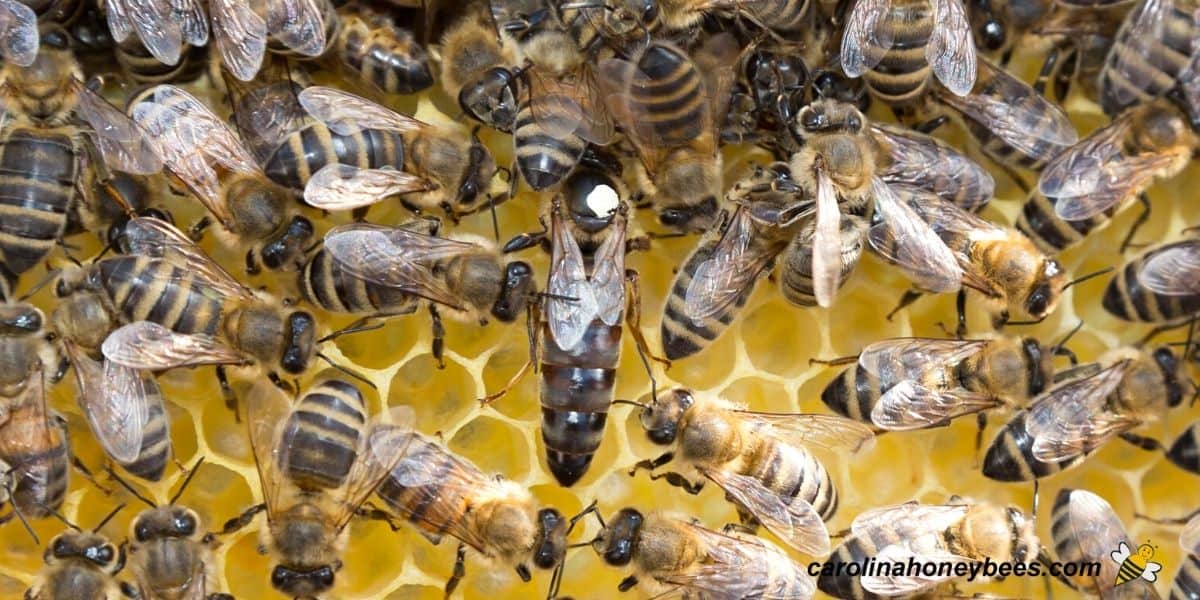
As she progresses through the same development stages that every bee goes through – colony survival is on the line. Egg laying will make her the mother of the colony. But, facts are – the queen does even more during her time in the hive.
Understanding the Queen Bee Life Cycle
As with any living thing, bees have a life cycle that consists of different stages. Every member of the colony begins as an egg -smaller than a grain of rice. This is true also for the most important member of the hive – the queen.
It would be a great story if the life span of a queen honey bee covered many peaceful years of the good life. Alas, that is not usually the case.
As if to keep this “royal bee” humble, her rule and very existence depends on the work of many individual bees. She does not feed or even clean herself but depends on care from others.
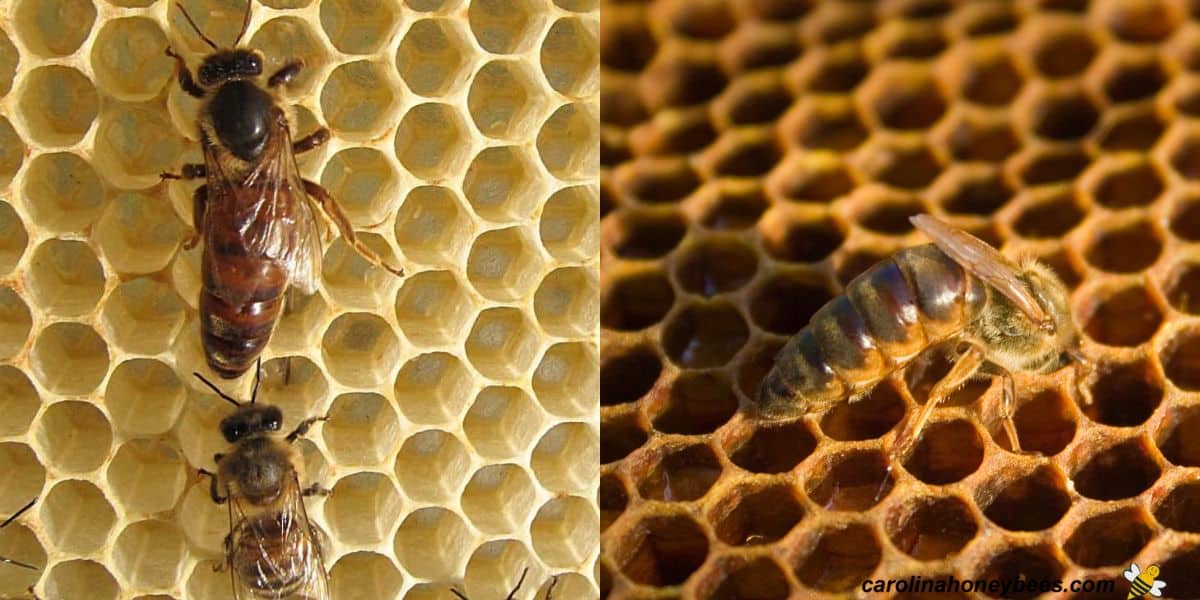
Duties of the Queen Honey Bee
Unlike workers, the duties of the queen do not change as she ages. She is the only member of the colony that lays fertilized eggs.
Fertilized eggs develop into worker bees and the colony needs thousands. This sexually mature reproductive female is the mother of all the members of the hive.
In addition, her special pheromones tie the colony together as a social unit. If she is missing, the colony becomes aware very quickly.
What Does a Queen Bee Look Like?
Learning how to recognize the queen in a hive of thousands takes some practice. Over time, beekeepers become better at being able to find their queen. Knowing how to mark a queen is a useful skill too.
Her thorax (mid-section is a little larger). She is longer with a large abdomen. This large abdomen holds a lot of eggs and stored semen (after mating).
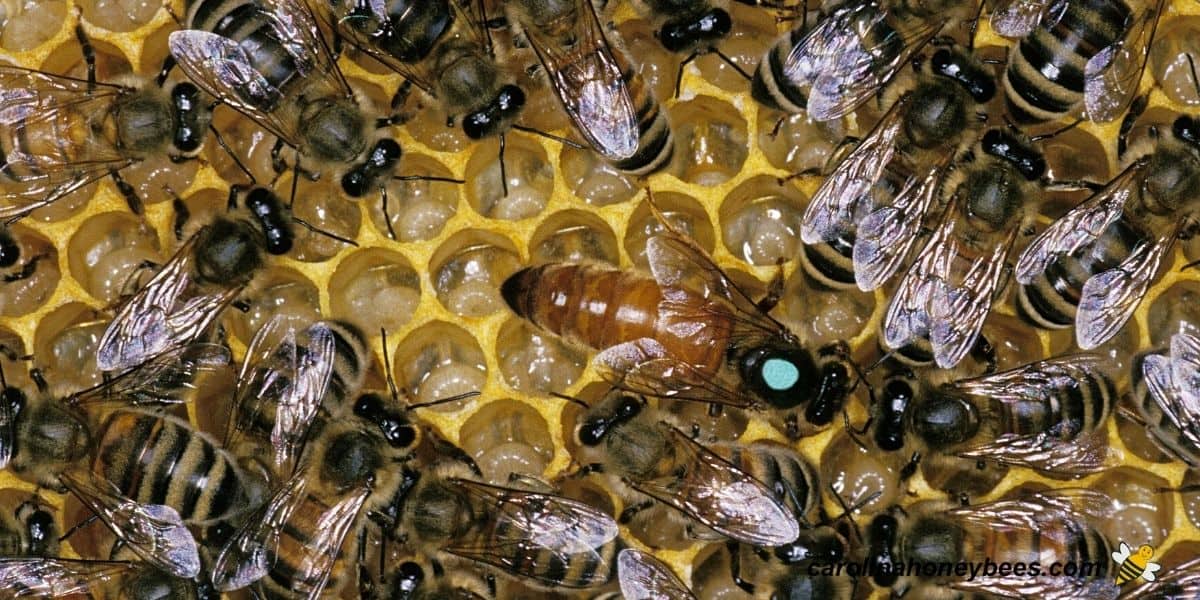
Why Colonies Create New Queens
From time to time, the colony will need a new queen. There are several reasons to replace the current monarch.
Perhaps the old queen has died or she may be reaching the end of her reproductive life. As she grows older, egg laying slows. There are only a limited number of eggs stored in the abdomen. When they are gone-that’s it.
She may also run out of stored semen. When she becomes unable to lay fertilized eggs, she becomes a drone-layer. The colony will kill a failing queen.
However, fresh fertilized eggs or very young bee larva are needed to make a queen. If the colony waits too long, they may not have the materials needed to replace her.
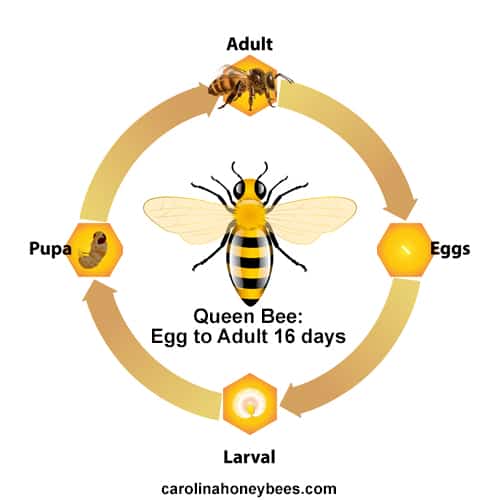
Life Stages of Honey Bees
Honey bees have the same development stages as other insects and pass thru 4 stages. Egg, larva, pupa and adult are the same life stages for all honey bees in the colony. This process is called complete metamorphosis.
- egg
- larva
- pupa
- adult
Worker bees become adults in 21 days on average. Drones (male honey bee) require 24 days to mature.
However, a queen bee can be produced in only 16 days! She has the shortest development time of any bee in the colony.
How Bees Make a Queen
The colony can produce a queen bee from any fertilized egg or very young female larva. Queen rearing takes place under 2 situations.
- routine queen replacement
- emergency queen rearing
In a planned replacement, the current queen is encouraged to lay eggs in special cells. Perhaps the colony senses that she is failing.
Or, they may simply want to create a new queen for swarming purposes. Either way, she is still available and able to lay eggs for a bit.
If the colony is in an emergency situation, the queen may be dead or missing from the hive. If still present, she is not able to lay fertilized eggs or lacking in some fashion.
In this case, workers select suitable female larvae already in the comb. Then, the special cells are enlarged around them.
The process of queen rearing begins early in the development process. In the beginning, any very young female larva (from a fertilized egg) has a chance to develop into a reproductive female.
But, the window of opportunity closes quickly. Larva older than 2 days do not make the best queens. This is why timing is important to the colony.
Routine Queen Replacement:
It is common for a colony to keep a few special cells in place. These acorn shaped cups are no cause for alarm. It is normal for some colonies to keep some cups on hand year round. Seeing a cup in your hive – or several is no reason to panic.

However, once a egg is laid in a cup – it is now called a queen cell. The queen bee life cycle has begun.
After 3 days, the egg hatches (it doesn’t really hatch like a chicken egg – the shell itself dissolves). It is now called a larva.
Larval Stage of Development
The larval stage of queen development is where the magic starts to happen. Nurse bees feed the larva a special solution produced from glands in their mouths.
Larva destined to become royalty (a queen), are fed an abundance of special food – including royal jelly.
The type and quantity of this larval diet is different than regular brood food. The special diet is what makes the larva develop into a queen rather than a worker bee!
These special larvae grow much larger than regular worker bees. They will not fit into regular honeycomb cells.
Worker bees build a large peanut shaped cell for the growing larva. This is the easily recognizable cell that we watch for and it is normal to have more than one at a time.
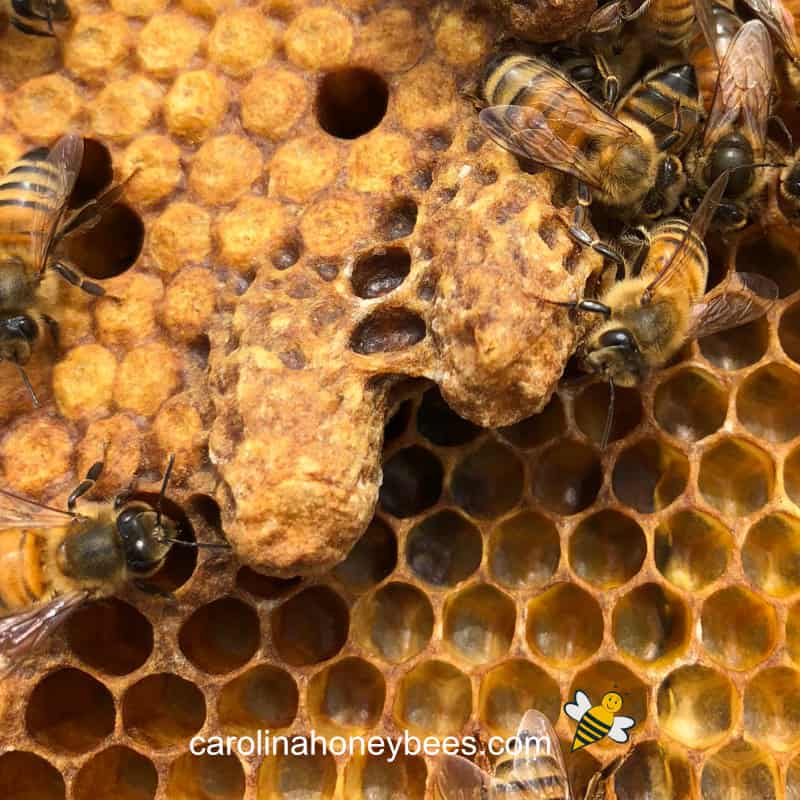
Pupa Stage
Around day 7 ½ (from egg laying) the larva is finished feeding and ready to transform to the next stage. Worker bees cap the cells with wax. On day 8, the larva becomes a pupa.
Inside this capped queen cell, the final transformation takes place. The larva spins a cocoon and changes from larva to pupa.
Adult Stage
Around day 16 a new queen will emerge from her cell. She is fully formed though her abdomen is smaller than it will be after mating.
What is the first thing this she does? She searches out any possible rivals in the hive. When she finds them, she will chew into the cell and kill the virgin queen inside. Being royal is messy business.
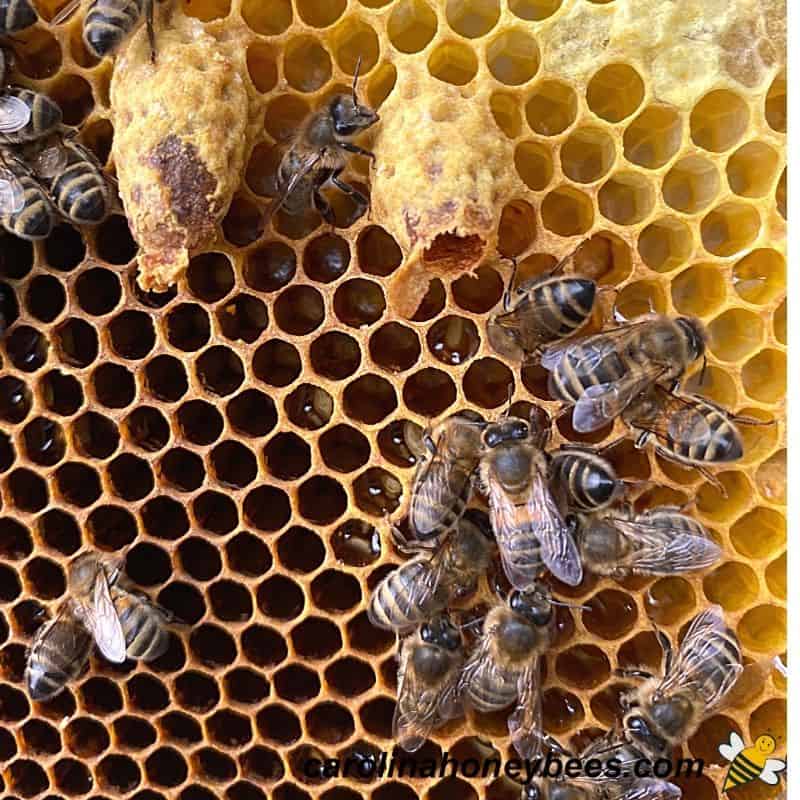
Queen Bee Mating
After emerging from her cell, the new virgin queen will mature for a few days. Then, she will leave the hive to mate in the air with drones.
Accompanied by a few workers she may fly a mile or more away from the hive. This helps ensure that she does not mate with drones closely related to her. 🙂
She takes several mating flights over the next few days. Once the special organ that stores semen inside her abdomen (Spermatheca) is full, her mating days are over.
After that time, she will never leave the colony again. (Unless the colony swarms). Her life cycle completes with her hard at work in the colony.
Emergency Queen Rearing
A colony does not always use a special cup. In an emergency situation, they will choose a fresh egg or young larva in a regular cell.
Perhaps the queen died quickly – or a beekeeper squished her? They must use a fresh larva that is already in place on the comb.
This is called emergency queen rearing and worker bees choose only the very youngest larva. Older larva may not develop into a quality queen bee because the nutrition of the first few days is so important.
The size of a queen bee is affected by feeding during development. Those reared in emergency conditions are not always the best quality.
How Long Does the Queen Bee Live?
Though she has the capacity to live for 5-6 years or more, that rarely happens. She will likely fail before then.
In my colonies, I rarely have a queen bee that lasts in the hive more than 2 years. It is often a much shorter reign. Some colonies replace poor performing queens after only a few months.
This is one of the challenges of beekeeping, to ensure that you have good queens in your hives. The quality of bees seems to be dropping in recent years with queen bee life spans growing shorter.
Final Thoughts
Our bee colonies have a remarkable ability to create a new reproductive female when needed. Given the right materials, a viable population and a little time, they can create a new queen when the life span of the current one comes to an end.
As beekeepers, it is our job to ensure that the colonies have a chance to continue.
https://carolinahoneybees.com/queen-honey-bee-life-cycle-buzz-buzz/
Queen bee's wedding flight.
https://www.youtube.com/watch?v=FaJ3K9qRVwo&t=8s










